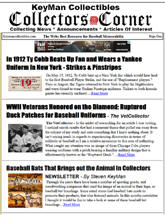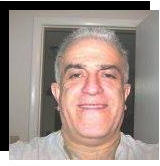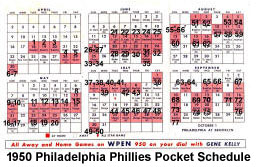|
Collecting News &
Articles of Interest |
 |
|
|
|
|
| KeyMan
Collectibles |
NEWSLETTER |
January 2018 |
|
|
How To Attribute the Game No. on Undated Tickets |
 |
|
David Shakir |
|
|
To Games Played
-
By David Shakir |
|
David Shakir
has compiled an extensive
study on ticket stubs
that did not included
dates on the tickets. Once the correct
year is established,
combined with a method for correctly
attributing the game number to
the actual game played, collectors can now
purchase special
event, and player
milestone tickets with
confidence. David is
also a PSA Consultant
specializing in Undated NY Yankees
Tickets. |
|
|
|
|
|
| |
Ask
David: Direct your questions or feedback, about
undated ticket stubs, New York
Yankees, Stadium/Grandstand or Bleacher ticket stubs to David Shakir
theshak13@gmail.com You can also contribute
to this on going study by sending David scans of your ticket
stubs, both front and back. |
|
|
|
|
| |
 When trying to attribute the game
number on a ticket without a date, to
the game played, it is important to
remember that all the baseball game
reference websites only list completed
official games played. Results and box
scores, in the order in which they were
played, both home games, and road
games. Games that were postponed, such
as with a rain out, are not listed.
There is also no indication for games
that were played after being
rescheduled. Simply counting down the
home games listed will give you an
inaccurate date for your numbered
ticket. When trying to attribute the game
number on a ticket without a date, to
the game played, it is important to
remember that all the baseball game
reference websites only list completed
official games played. Results and box
scores, in the order in which they were
played, both home games, and road
games. Games that were postponed, such
as with a rain out, are not listed.
There is also no indication for games
that were played after being
rescheduled. Simply counting down the
home games listed will give you an
inaccurate date for your numbered
ticket.

The method used to attribute the game number on an undated ticket stub, to the
correct date of the game played, starts with the team's Home
Schedule. With the
schedule, give each home game its
specific game number. Home game no. 1
through home game no. 77 for a 154 game
schedule, and 1-81 for a 162 game
schedule. Each game will have the date
it was scheduled to be played.
 Then after each home game is numbered, we can cross-reference it with the
games played & results schedule. By
comparing the dates for the games
scheduled, to the dates the games were
played on the results schedule, we can
determine which games were never
played; which games were makeup games,
and if they were played on an off-day,
or added to a scheduled single game, played as a double Header. Then after each home game is numbered, we can cross-reference it with the
games played & results schedule. By
comparing the dates for the games
scheduled, to the dates the games were
played on the results schedule, we can
determine which games were never
played; which games were makeup games,
and if they were played on an off-day,
or added to a scheduled single game, played as a double Header.
Official
schedule double headers count as two
game numbers but the number of the first
game was used for admittance to both
games. However, separate game admission
for a Holiday Double Header was common
in the 1930's, and two separate ticket
No.'s were used for admittance to each
game. This happened in 1925, 1932,
to 1936. These games on the team's
official schedule will be marked with
AM & PM.
|
|
| |
 |
|
| |
Another thing you should be aware of
are Synthetic double headers. Heading
into the 1930's baseball saw a major
decline in week-day afternoon single
game attendance, due in part to the
great depression, and high
unemployment. To boost gate receipts
Baseball offered two games for the
price of one. What they did was remove
a scheduled single week-day game and
added it to a Sunday game earlier in
the season. They called it a "Synthetic
Double Header" (Synthetic Double
Headers, were sometimes created due to
stress on the schedule caused by
excessive Rain outs)
 Tickets
for games that were postponed for any
reason, due to rain, or darkness
(before the use of lights) were voided.
Rain checks were used to exchange for
any future regular season game of same
price. If the "Make Up Game" for the
postponed game was added to another
scheduled game to create a double
header, the ticket number of that
scheduled game was used for admission
to both games. If the postponed game
was made up on an off day, an "Extra"
or "Emergency" ticket was issued for
admission. Most teams reserved tickets
printed before the season that featured
a letter in place of a game number. Tie
games played to the regulation 5 innings or more
before being called off, were official.
The game was rescheduled and played
from the start. Tickets
for games that were postponed for any
reason, due to rain, or darkness
(before the use of lights) were voided.
Rain checks were used to exchange for
any future regular season game of same
price. If the "Make Up Game" for the
postponed game was added to another
scheduled game to create a double
header, the ticket number of that
scheduled game was used for admission
to both games. If the postponed game
was made up on an off day, an "Extra"
or "Emergency" ticket was issued for
admission. Most teams reserved tickets
printed before the season that featured
a letter in place of a game number. Tie
games played to the regulation 5 innings or more
before being called off, were official.
The game was rescheduled and played
from the start.
|
|
| |
KEYMAN COLLECTIBLES
RELATED RESOURCES |
|
| |
|
|
| |
NEW YORK YANKEES GRANDSTAND TICKET STUB
DATING GUIDE HOME |
|
| |
 |
|
|
|
|
|


